A Work Breakdown Structure (WBS) is a fundamental tool in project management that breaks a project into smaller, manageable components. By organizing work into a hierarchical structure, WBS enhances task clarity, improves resource allocation, and helps teams manage risks more effectively. This structured approach prevents scope creep and ensures better project tracking and execution.
Work Breakdown Structure plays a crucial role in project planning by supporting scheduling, budgeting, and risk management. Defining the project scope, gathering stakeholder input, and establishing control accounts are essential steps before creating the WBS. After its creation, monitoring, refining, and integrating it with project management tools help maintain project alignment.
A typical WBS consists of multiple hierarchical levels, starting from project objectives and major deliverables to work packages and detailed tasks. It follows key principles such as the 8/80 rule, which ensures work packages are neither too small nor too large, and the 100% rule, which confirms that the sum of all tasks accounts for the entire project scope.
Different types of WBS exist, including Deliverable-Based WBS, which organizes work around tangible outputs, Phase-Based WBS, which categorizes tasks according to project lifecycle stages, and Work Package-Based WBS, which groups tasks based on team responsibilities.
A well-structured WBS is essential for optimizing efficiency, reducing risks, and improving project outcomes. Whether used in manufacturing, software development, or general project management, a robust WBS is a cornerstone for structured project planning and execution.
What is a Work Breakdown Structure?
A Work Breakdown Structure (WBS) is a hierarchical framework that divides a project into smaller, manageable sections, helping teams organize tasks, allocate resources, and track progress. This structured approach, often named as “task breakdown” and visualized as a tree structure, ensures that each phase aligns with project objectives and contributes to overall success.
The WBS may also be considered as the taxonomy of a project, systematically categorizing all work elements, according to Shlomo Globerson in Impact of Various Work-Breakdown Structures on Project Conceptualization. This structured classification ensures that every work package contributes to the overall project scope while maintaining clarity in execution.
A Work Breakdown Structure helps in decomposing the project deliverables into smaller work elements that are easier to manage and assign responsibilities, according to Wikipedia. It is often named as “workflow breakdown” and represented graphically in a hierarchical format, resembling a tree diagram, to provide clarity and structure.
By breaking down a project into logical and structured segments, WBS helps teams define project scope, avoid ambiguity, and ensure all tasks are accounted for. It serves as a foundation for detailed planning, scheduling, cost estimation, and risk management, making it an essential component in modern project management methodologies.
This visual example illustrates the hierarchical and granular nature of a Work Breakdown Structure, showcasing how project scope is broken down into increasingly detailed components.
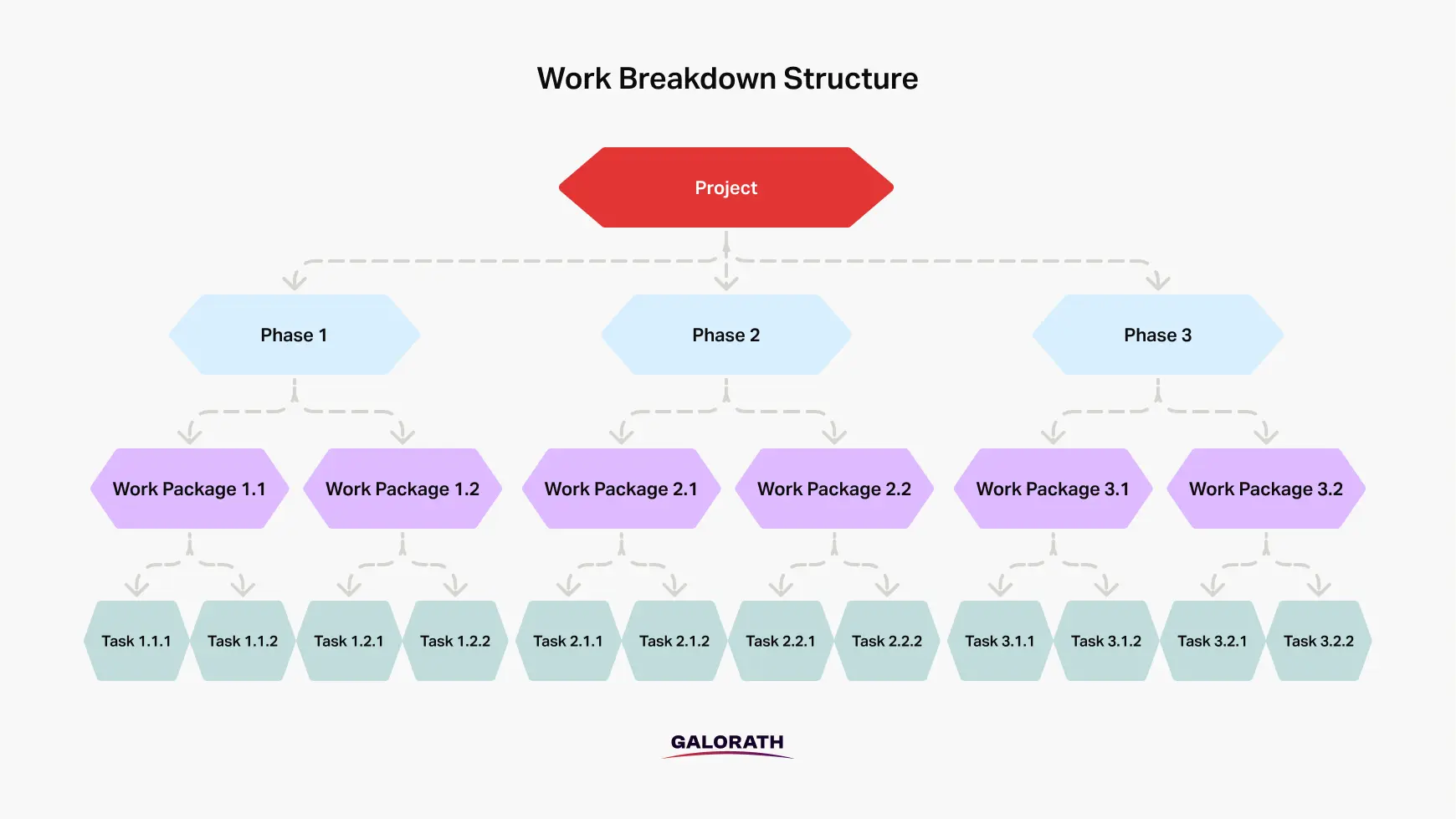
What are the elements of a Work Breakdown Structure?
The elements of WBS define the fundamental parts of a work breakdown structure and establish its framework for managing projects effectively. These WBS elements are essentially parts of a work breakdown structure, and they ensure structured planning, task assignment, and seamless execution.
These are the 7 most common WBS elements:
- WBS Dictionary – A WBS dictionary provides detailed descriptions for each element of WBS, including definitions, assigned resources, cost estimates, and scheduling details. It serves as a reference guide to prevent ambiguity and ensures clarity in project execution.
- Deliverables – Parts of a work breakdown structure include major deliverables that represent the key outputs of a project. These tangible results define what needs to be accomplished for project success.
- Work Packages – A work package is the lowest level of WBS and contains specific tasks required to complete a deliverable. Work packages help in assigning resources, tracking progress, and estimating costs efficiently.
- Tasks and Subtasks – Tasks and subtasks break down work packages into smaller units, making them manageable and ensuring clarity in execution. Each task contributes to the project scope and aligns with broader project goals.
- Control Accounts – Control accounts serve as financial and performance monitoring points within a WBS element. They help track progress, manage budgets, and ensure alignment with project objectives.
- Milestones – Milestones mark significant project phases or key achievement points. These checkpoints enable teams to measure progress and ensure project timelines stay on track.
- WBS Levels – The hierarchical levels of WBS structure the project from high-level objectives down to detailed work elements. Typically, these levels start with project objectives and progress down to tasks and subtasks.
Shown here are seven of the most common elements typically included in a Work Breakdown Structure (WBS).
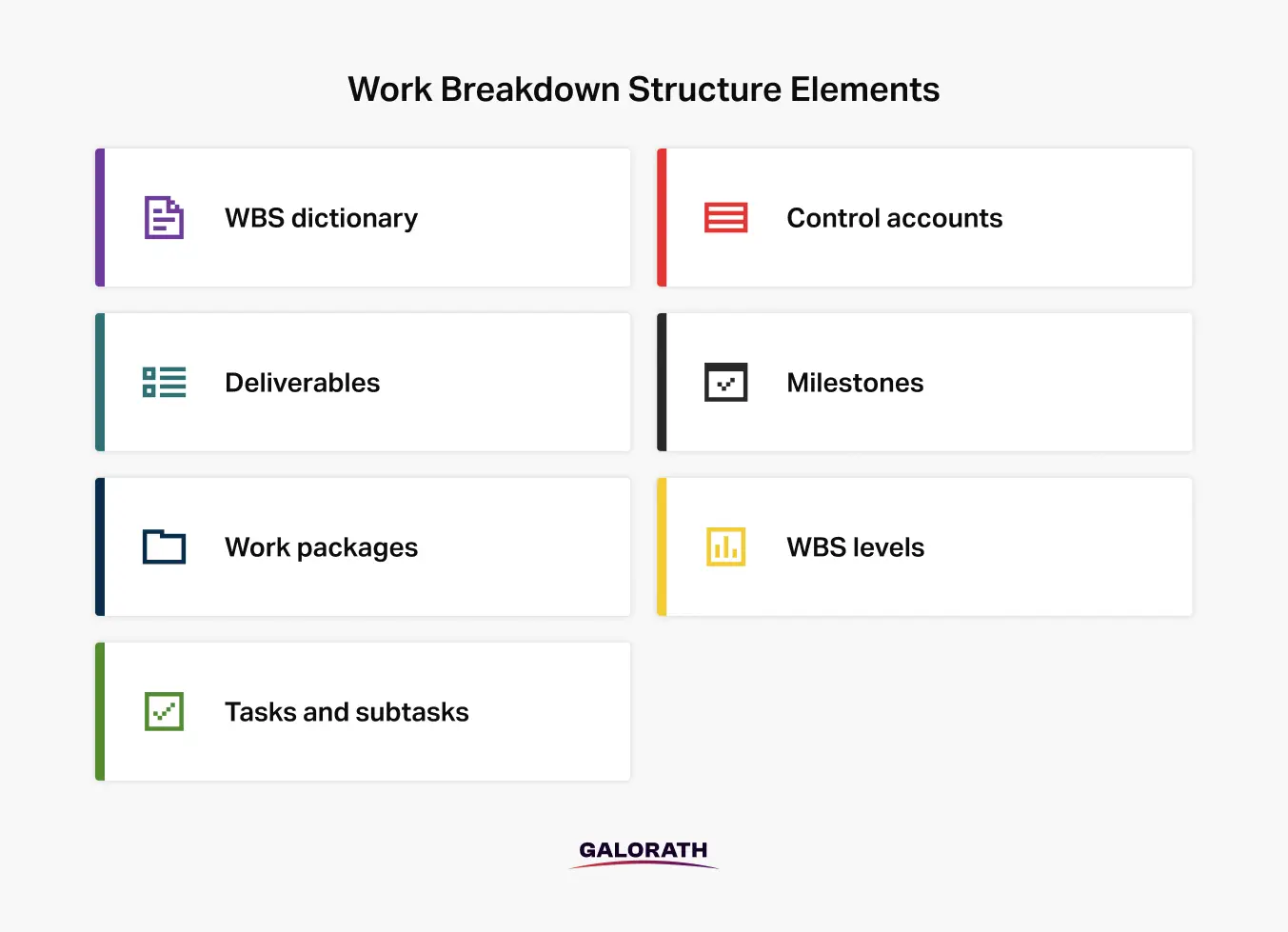
These elements of WBS, give project managers the ability to build a durable structure that streamlines execution and enhances project visibility.
Why Use a Work Breakdown Structure in Project Management?
A WBS enhances project execution by improving resource allocation, scope definition, and budget tracking. It minimizes scope creep by clearly identifying all necessary activities and allows teams to assign costs and time estimates to each work package, leading to better financial planning.
Moreover, breaking down a project into structured task components helps teams identify risks early, making it easier to address potential issues before they impact the entire project.
When is WBS Used in Project Management?
A WBS is primarily used in the project planning phase as it provides a foundation for structuring tasks, defining deliverables, and aligning resources. During this phase, project managers use WBS to develop comprehensive budgets and schedules, ensuring that all aspects of the project are accounted for.
As stated by Lanford & McCann in Effective Planning and Control of Large Projects, a WBS enhances visibility and control during project execution, providing structure and clarity. By establishing a hierarchical breakdown of tasks, teams can create detailed work packages that support accurate cost estimation and time management.
Beyond planning, WBS continues to play a role throughout the project lifecycle. It supports execution by offering a structured approach to tracking progress, managing risks, and ensuring that resources are allocated effectively. During project monitoring and control, WBS aids in performance evaluation by measuring completed tasks against planned deliverables, allowing for adjustments as needed.
A WBS is critically important in large and complex projects where coordination across multiple teams is required. It enables seamless communication and accountability by clearly defining work responsibilities. Whether in manufacturing, software development, engineering, or IT projects, WBS remains a vital tool for ensuring project success through structured organization and systematic execution.
Who usually creates the Work Breakdown Structure?
The creation of a Work Breakdown Structure (WBS) involves multiple key roles within a project team, each contributing their expertise to ensure a well-structured and effective breakdown. The most common roles responsible for developing a WBS include:
- Project Manager – Leads the WBS creation process, ensuring that it aligns with project objectives, scope, and resource planning. The project manager oversees the breakdown of tasks, assigns responsibilities, and ensures that all elements are clearly defined.
- Project Team Members – Provide input on specific tasks and deliverables based on their areas of expertise. They help define work packages, estimate resource requirements, and validate task dependencies.
- Stakeholders – Offer insights into project goals, requirements, and deliverables. Their feedback ensures that the WBS accurately reflects project expectations and aligns with organizational priorities.
- Subject Matter Experts (SMEs) – Bring specialized knowledge to define technical tasks, estimate effort, and identify potential risks within work packages.
- Business Analysts – Assist in refining the scope and ensuring that the WBS captures all functional and non-functional requirements, improving project clarity and execution.
- Schedulers and Cost Estimators – Work alongside the project manager to integrate time and cost estimates into the WBS, enabling accurate financial planning and scheduling.
What are the 8 benefits of Work Breakdown Structure?
The benefits of a Work Breakdown Structure (WBS) are many because a WBS delivers an array of advantages to project managers by ensuring projects are well-structured and manageable.
The primary 8 benefits of creating a Work Breakdown Structure include:
- Improved Project Clarity – WBS ensures all tasks are well-defined, reducing ambiguity and misunderstandings among team members.
- Enhanced Resource Allocation – By breaking down the project into smaller components, resources can be assigned more effectively to each task, optimizing productivity.
- Better Budgeting and Cost Estimation – WBS enables precise financial planning by associating costs with specific work packages, improving budget accuracy.
- Minimized Scope Creep – Clearly defining work elements prevents unnecessary changes and keeps projects aligned with initial goals.
- Increased Accountability – Assigning specific responsibilities to different team members fosters ownership and ensures work is completed on schedule.
- Risk Identification and Mitigation – A structured WBS helps teams identify potential risks early, allowing for proactive mitigation strategies.
- Efficient Progress Tracking – Managers can monitor project performance by tracking progress against clearly defined deliverables.
- Seamless Integration with Project Management Tools – WBS can be incorporated into scheduling and tracking software to improve workflow management.
The image below highlights eight key benefits of creating a Work Breakdown Structure (WBS).

Levels of a Work Breakdown Structure
The levels of a Work Breakdown Structure (WBS) represent the hierarchical breakdown of a project into progressively smaller and more manageable components. Each level plays a crucial role in defining work elements, ensuring accountability, and maintaining project clarity. These levels create a structured approach that connects high-level project goals to individual tasks, providing a roadmap for successful execution.
The hierarchical structure of WBS levels ensures that work elements are clearly defined, dependencies are identified, and resources are appropriately allocated. This breakdown improves coordination among teams, facilitates progress tracking, and aligns deliverables with project objectives.
Work Breakdown Structure consists of 4 hierarchical levels:
- Project Objective
- Major Deliverables
- Work Packages
- Tasks and Subtasks (Terminal elements)
1. Project Objective
The first and highest level of the WBS is the Project Objective. This level defines the overarching goal of the project and sets the foundation for all subsequent work elements. It represents the final deliverable that the project team aims to achieve. The project objective must be clearly stated to ensure alignment with stakeholder expectations and organizational goals.
2. Major Deliverables
The second level of the WBS consists of Major Deliverables. These are the key project outcomes required to fulfill the project objective. Major deliverables break down the overarching goal into large, manageable sections. Each deliverable represents a significant component of the project and serves as a checkpoint to measure progress.
For example, in a software development project, major deliverables might include system architecture, UI/UX design, and backend development. These high-level work segments ensure a structured approach to project execution and resource allocation.
3. Work Packages
The third level of the WBS is composed of Work Packages. A work package is a collection of related tasks grouped together to produce a specific outcome. These work packages are detailed enough to allow for task assignment, resource planning, and scheduling.
Work packages typically follow the 8/80 rule, meaning they should take no fewer than 8 hours and no more than 80 hours to complete. This ensures that work elements remain manageable without becoming overly granular.
For example, within the UI/UX design deliverable, work packages might include wireframe creation, prototype development, and user testing. Each work package is assigned to a specific team or individual, ensuring accountability and tracking.
4. Tasks and Subtasks (Terminal Elements)
The fourth and lowest level of the WBS consists of Tasks and Subtasks, also known as Terminal Elements. These are the smallest units of work required to complete a work package. Tasks and subtasks provide the most detailed level of planning, specifying exactly what needs to be done, by whom, and within what timeframe.
Terminal elements are crucial for project execution as they directly contribute to deliverables and must be clearly defined to avoid ambiguity. They represent the final breakdown of work before execution begins and are used for scheduling, resource allocation, and performance measurement.
For example, within the prototype development work package, tasks may include designing user interface elements, implementing interactive components, and gathering stakeholder feedback. Each of these tasks can be further broken down into subtasks to ensure detailed execution.
By structuring a project into these four levels, a Work Breakdown Structure ensures that all work elements are clearly defined, responsibilities are assigned, and progress is effectively tracked. This hierarchical breakdown enhances efficiency, reduces risks, and increases the likelihood of project success.
This visual representation highlights the four structured levels within a work breakdown structure.
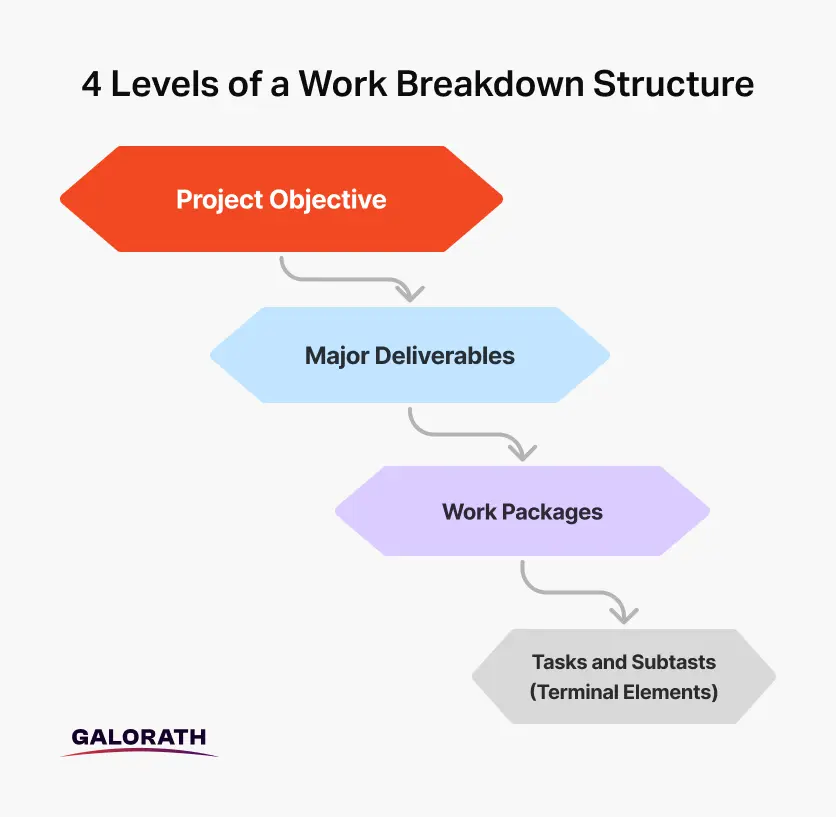
The 8/80 Rule in WBS
The 8/80 rule in WBS is a principle that suggests a work package should take no fewer than 8 hours and no more than 80 hours to complete. This rule ensures that tasks are of a manageable size—neither too granular nor too broad—allowing for efficient tracking, resource allocation, and accountability. If a task is estimated to take less than 8 hours, it may be too detailed and should be grouped with similar tasks. Conversely, if a task exceeds 80 hours, it should be further decomposed into smaller work packages to maintain oversight and control.
Applying the 8/80 rule in WBS improves project execution by preventing tasks from becoming overly complex or too insignificant to monitor effectively. It ensures that tasks remain actionable and within a reasonable scope, facilitating better progress tracking and adherence to timelines. This principle is widely used in project management frameworks, particularly in industries where structured work decomposition is essential for maintaining efficiency and predictability.
The 100% Rule in WBS
The 100% rule in WBS is a fundamental principle ensuring that the sum of all work at each level represents 100% of the total project scope. According to the Practice Standard for Work Breakdown Structures (Second Edition) published by the Project Management Institute (PMI), this rule mandates that all deliverables—internal, external, and interim—are captured within the WBS. It applies at every level of the hierarchy, meaning that the collective effort of lower-level tasks must fully account for the higher-level work they support.
This principle prevents missing tasks or redundant work, ensuring that all necessary components of a project are accounted for without exceeding the project’s defined scope. The 100% rule in WBS also extends to activity levels, where the work represented by tasks within each work package must sum up to the entirety of that package’s required effort.
By adhering to the 100% rule, project teams maintain clarity, avoid misallocation of resources, and ensure comprehensive tracking of project components.
Types of Work Breakdown Structures
Different types of WBSs exist because projects vary in structure, industry, and complexity, requiring a tailored approach to organization and management. The classification of WBS types is based on how work elements are structured, whether by deliverables, phases, functions, or risks. Each type of WBS serves a specific purpose in improving project tracking, team collaboration, and accountability.
There are 5 primary types of WBS structures:
- Deliverable-Based WBS
- Phase-Based WBS
- Work Package-Based WBS
- Functional WBS
- Risk-Based WBSW
1. Deliverable-Based WBS
A Deliverable-Based Work Breakdown Structure organizes work around tangible outputs, such as reports, software features, or completed structures. This type ensures that each deliverable is well-defined and measurable, allowing teams to track progress effectively. It is commonly used in product development, engineering, and construction projects, where clear deliverables are essential for success.
2. Phase-Based WBS
A Phase-Based Work Breakdown Structure categorizes tasks according to the different stages of the project lifecycle, including planning, execution, monitoring, and closure. This type of WBS is especially useful for long-term projects with distinct phases, ensuring that work progresses systematically from one stage to the next. It helps project managers maintain control over each phase, reducing the risk of scope creep.
3. Work Package-Based WBS
A Work Package-Based Work Breakdown Structure assigns tasks based on team responsibilities and functional areas rather than deliverables or phases. This approach is particularly effective in agile environments and matrix-based project teams, where cross-functional collaboration and iterative development are essential. Work package-based WBS allows teams to focus on their specific scope of work without overlapping responsibilities.
4. Functional WBS
A Functional Work Breakdown Structure organizes tasks based on departments or functional areas, such as finance, marketing, engineering, or IT. This structure ensures that each team or department has clear ownership over their respective tasks, improving accountability and coordination in large-scale projects. It is commonly used in corporate environments where multiple business functions contribute to project execution.
5. Risk-Based WBS
A Risk-Based Work Breakdown Structure focuses on potential project risks and categorizes work elements based on risk factors. This approach allows project managers to proactively address high-risk areas, allocate contingency resources effectively, and develop mitigation strategies to prevent project delays and budget overruns. It is particularly useful in industries such as aerospace, healthcare, and finance, where managing risks is critical to success.
Each of these WBS types exists to accommodate different project needs and ensure that tasks are structured in a way that best supports project success. By selecting the appropriate type of WBS, teams can improve planning, resource allocation, and execution efficiency.
Work Breakdown Structure vs. Gantt Charts
After Work Breakdown Structure defines which tasks need to be done in a project, Gantt chart is used to visualize when tasks should be completed and their dependencies.
For example, in a product launch, a WBS may outline phases like market research, development, testing, and deployment. A Gantt chart then maps out each phase’s timeline, helping teams manage deadlines and dependencies efficiently.
Work Breakdown Structure vs. Cost Breakdown Structure
A Cost Breakdown Structure (CBS) is used to organize costs based on budget categories, after Work Breakdown Structure (WBS) creates hierarchical work elements in a project. CBS categorizes expenditures such as labor, materials, and overhead costs. By integrating both Cost and Work structures, project managers can align work execution with financial planning, improving budget tracking.
Work Breakdown Structure vs. Organizational Breakdown Structure
Organizational Breakdown Structure (OBS) maps team roles and responsibilities, for individual deliverables and tasks made by a Work Breakdown Structure. It is essentially a framework that arranges a company’s workforce into a structured hierarchy, showing how different roles and departments relate and interact with one another. The WBS ensures project tasks are well-defined, while the OBS clarifies accountability. OBS ensures that tasks are assigned to the right teams within the organization.
Work Breakdown Structure vs Work Breakdown Schedule
A Work Breakdown Schedule (WBSchedule), is a timeline-driven tool that arranges WBS elements into a structured schedule. The Work Breakdown Schedule builds upon the WBS by assigning start and end dates, dependencies, and durations to the work packages and tasks. It is used for tracking project progress, managing deadlines, and ensuring that work is completed within the planned timeframe.
The 4 main Differences between Work Breakdown Structure and Work Breakdown Schedule are:
- Focus: WBS defines what work needs to be done, while WBSchedule defines when the work should be done.
- Structure: WBS is a hierarchical visualization of project elements without time constraints, while WBSchedule incorporates scheduling, dependencies, and deadlines.
- Purpose: WBS ensures clarity in project scope and accountability, whereas WBSchedule ensures proper time management and workflow efficiency.
- Usage: WBS is typically used during the planning and structuring phases of a project, while WBSchedule is utilized during the execution and tracking phases to monitor progress.
By using both a WBS and a Work Breakdown Schedule, project managers can ensure that work is well-defined, properly scheduled, and executed efficiently.
Work Breakdown Structure vs Process Breakdown Structure
A Process Breakdown Structure (PBS) focuses on the workflow and processes required to complete a project, while WBS is focused on deliverables and decomposes a project into smaller, manageable work packages. PBS outlines the sequence of activities and dependencies between tasks, ensuring that the project progresses efficiently from initiation to completion. Instead of focusing on deliverables, a PBS emphasizes the steps, methods, and procedures needed to achieve project objectives.
This image shows a comprehensive comparison between WBS, Cost Breakdown Structure, Organizational Breakdown Structure and Work Breakdown Schedule:
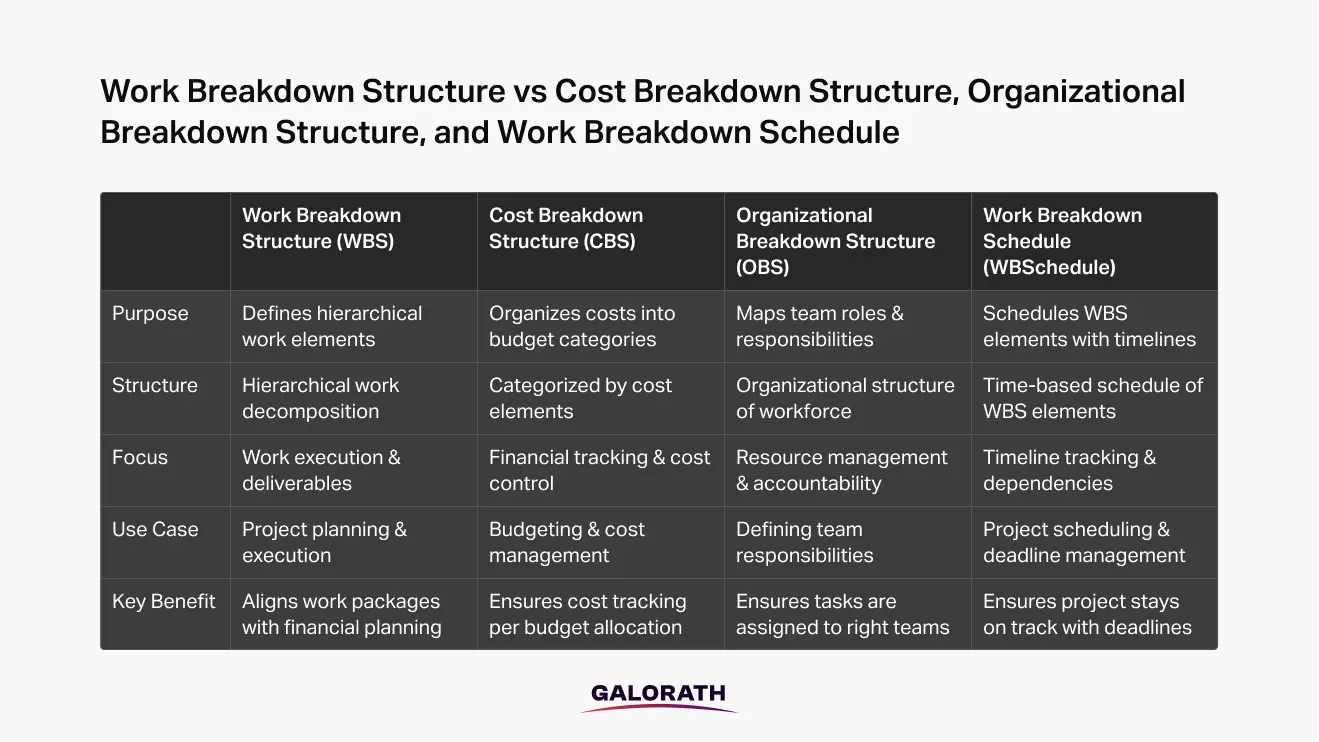
What is a Product Breakdown Structure?
A Product Breakdown Structure is a method that organizes project work based on the physical components or features of a product rather than project phases. It focuses on breaking down a product into its constituent parts, ensuring that each element contributes to the overall functionality and purpose of the product.
A Product Breakdown Structure is commonly used in hardware development, automotive engineering, construction projects, and software development, where different modules or features must be designed, built, and integrated systematically. By focusing on the structure of the final product, this approach enhances efficiency, reduces waste, and ensures that the end result meets all required specifications.
The 5 Differences between Product and Work Breakdown Structure:
- Focus: PBS focuses on the physical components of a product, whereas WBS focuses on the tasks and activities required to complete the project.
- Structure: PBS organizes work around tangible product features and their hierarchy, whereas WBS organizes work around deliverables, processes, and responsibilities.
- Usage: PBS is primarily used for product design, engineering, and manufacturing, whereas WBS is used for project planning, execution, and tracking.
- Deliverables vs. Work Execution: PBS outlines what the final product consists of, whereas WBS outlines how the project team will achieve the final product.
- Application in Project Management: PBS is useful for ensuring product completeness and quality control, whereas WBS is used for budgeting, scheduling, and resource allocation.
7 Challenges in WBS Creation and Implementation
Creating and implementing a Work Breakdown Structure (WBS) can be challenging, and organizations must navigate through these challenges in order to ensure project success.
Below are the 7 most common challenges encountered during WBS creation and implementation:
1. Defining the Appropriate Level of Detail
One of the primary challenges is determining how granular the WBS should be. Overly detailed WBS can lead to unnecessary complexity, while insufficient detail may result in ambiguity and oversight. Striking the right balance is essential to provide clear guidance without overwhelming the project team. As noted by Ten Six Consulting, going into too much or too little detail can hinder effective project planning and execution.
2. Avoiding Task Sequencing During WBS Development
Teams may inadvertently focus on the sequence of tasks while developing the WBS, which can detract from its primary purpose of defining what work needs to be done, not when. Prematurely considering task order can complicate the WBS and lead to confusion. It’s important to separate the identification of tasks from their scheduling.
3. Ensuring Comprehensive Scope Coverage
A well-constructed WBS must encompass 100% of the project scope, capturing all deliverables and work components. Failure to include all aspects can lead to scope creep, budget overruns, and missed deadlines. Regular reviews and updates of the WBS are necessary to reflect any changes in project scope and to maintain alignment with project objectives.
4. Not Developing a WBS Dictionary
Neglecting to create a WBS Dictionary can result in misunderstandings and miscommunications regarding the scope and deliverables of each WBS element. A WBS Dictionary provides detailed descriptions of each component, including milestones, deliverables, activities, and scope, ensuring that all stakeholders have a common understanding of the project’s work elements.
5. Managing Time Constraints in WBS Development
Developing a comprehensive WBS can be time-consuming, especially for large and complex projects. This process requires a thorough understanding and analysis of the project, which can delay the project’s actual start. Balancing the time invested in creating the WBS with project timelines is crucial to avoid unnecessary delays.
6. Confusing Deliverables with Tasks
A frequent mistake while creating a Work Breakdown Structure (WBS) is misidentifying deliverables as tasks. A deliverable is the intended result of a project, whereas a task represents the work required to achieve that result. Failing to distinguish between these elements can lead to misallocated resources, lack of clarity in project scope, and inefficiencies in execution.
For example, in a manufacturing project, consider the production of an electric vehicle:
- Deliverable: A fully assembled electric car ready for market release.
- Task: Assembling the battery module, installing the electric drivetrain, or painting the car body.
In this case, the deliverable is the end product, while the tasks are the specific activities that contribute to achieving it. Treating tasks as deliverables—or vice versa—can result in improper project breakdown, leading to inefficiencies in scheduling, resource allocation, and milestone tracking.
7. Using Manual vs. Automated WBS Tools
Relying on manual tools like spreadsheets and Excel for WBS creation can lead to inefficiencies, inconsistencies, and errors. Manual methods require constant updates, making it difficult to maintain version control and track changes.
Automated WBS tools and software solutions, on the other hand, streamline structuring, cost estimation, and scheduling. They improve accuracy, enhance collaboration, and integrate with project management systems to reduce manual effort and optimize workflow.
This illustration outlines seven common challenges organizations face when creating and implementing a Work Breakdown Structure.
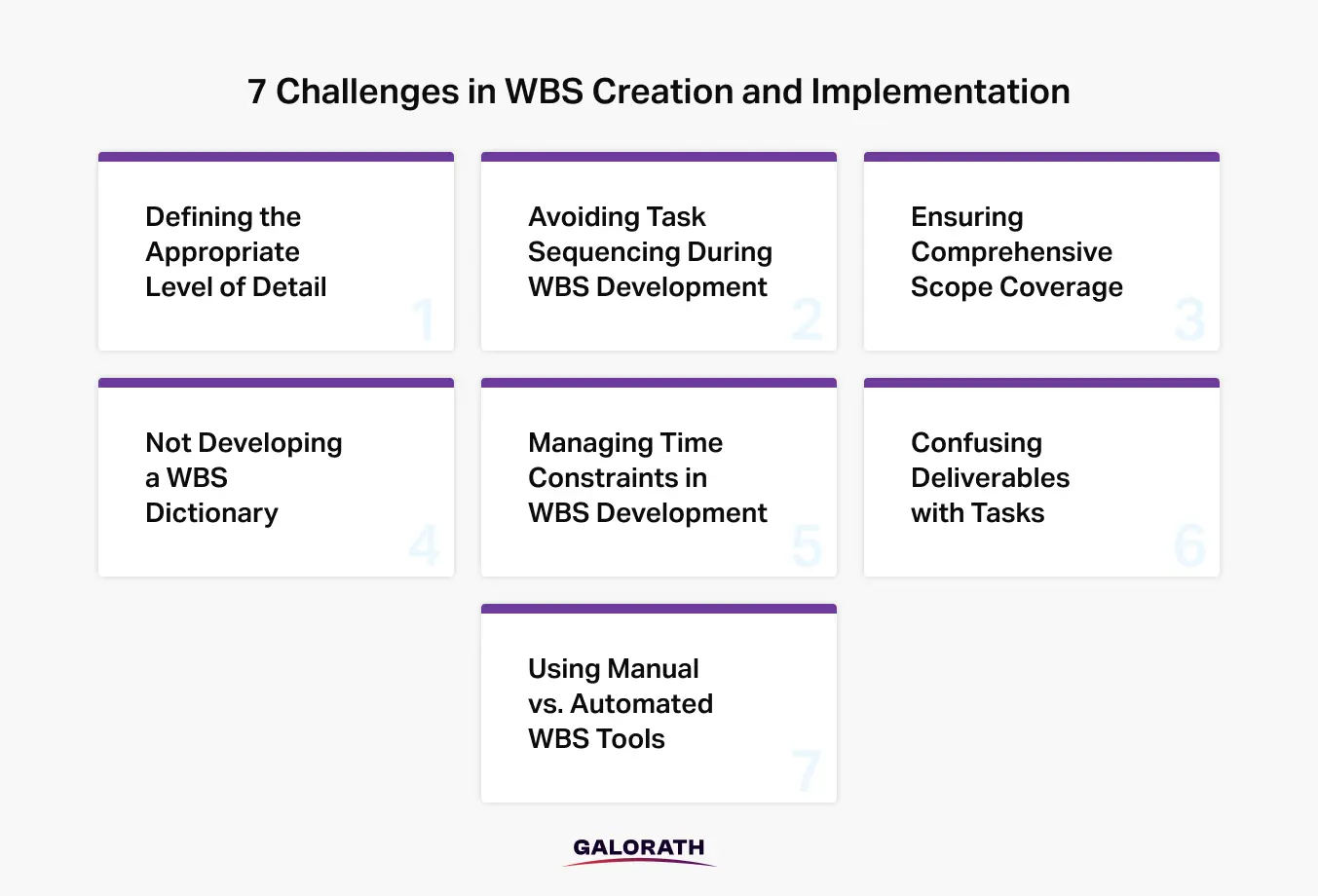
How to Create a Work Breakdown Structure?
To create a Work Breakdown Structure (WBS), project managers usually use digital project management tools such as Microsoft Project, Wrike, or Primavera, which allow teams to visually structure work packages, assign responsibilities, and integrate scheduling. In smaller-scale projects, WBS can also be developed using spreadsheets or even on paper.
The complexity and time required to develop a WBS depend on factors such as project size, industry requirements, and stakeholder involvement. For example, a WBS for a simple website redesign may take a few hours to create, while a WBS for constructing a high-speed rail system may require weeks of collaboration and refinement.
Creating a Work Breakdown Structure involves 2 key phases:
- Preparation & Structuring Phase
- Assignment & Refinement Phase.
Phase 1: Preparation and Creation of WBS
Before creating a WBS, project managers must establish a clear framework that defines the project scope, aligns with stakeholder expectations, and segments work into structured deliverables. This phase lays the foundation for an effective WBS that supports project tracking, scheduling, and resource allocation.
6 Key Elements of Preparation and Creation in Work Breakdown Structure:
- Define Project Scope and Objectives
- Gather Stakeholder Input
- Develop a Project Charter
- Identify Major Deliverables
- Establish Project Phases
- Set Control Accounts
1. Define Project Scope and Objectives
A clear project scope ensures that the WBS accurately reflects all required work. Defining the scope involves identifying key deliverables, expected outcomes, and constraints to prevent scope creep and inefficiencies.
2. Gather Stakeholder Input
Stakeholders play a critical role in shaping the WBS. Engaging key team members, clients, and decision-makers early in the process ensures alignment with project needs and expectations.
3. Develop a Project Charter
A project charter provides a high-level overview of the project’s purpose, constraints, risks, and high-level requirements. This document serves as a reference point when developing the WBS.
4. Identify Major Deliverables
Breaking down the project into high-level deliverables allows teams to segment work logically. These deliverables become the foundation for further decomposition into smaller work packages.
5. Establish Project Phases
Segmenting the project into phases (e.g., planning, execution, closure) ensures that work is structured in a way that supports efficient progress tracking and risk mitigation.
6. Set Control Accounts
Control accounts are checkpoints within the WBS that help monitor cost and performance. They allow project managers to track progress and ensure financial accountability.
Phase 2: Assignment and Refining the WBS
Once the WBS has been structured, it must be integrated into the project management framework by assigning responsibilities, refining deliverables, and implementing monitoring mechanisms. This phase ensures that the WBS remains functional and adaptable throughout the project lifecycle.
6 Key Elements of Assignment and Refinement phase in Work Breakdown Structure:
- Assign Responsibilities
- Develop Detailed Task Descriptions
- Establish Monitoring Mechanisms
- Review and Refine the WBS
- Integrate with Project Management Tools
- Communicate Progress
1. Assign Responsibilities
Each work package must have a designated owner responsible for execution, quality control, and timely completion. Assigning clear responsibilities ensures accountability and prevents miscommunication.
2. Develop Detailed Task Descriptions
To avoid ambiguity, each task within a work package should have a detailed description outlining objectives, dependencies, required resources, and expected outcomes.
3. Establish Monitoring Mechanisms
Tracking project performance involves setting up reporting tools and dashboards to monitor work progress, cost, and quality. This step helps prevent bottlenecks and inefficiencies.
4. Review and Refine the WBS
A WBS should be a living document, updated as needed to reflect changes in project scope, priorities, or resource allocation. Periodic reviews ensure that the WBS remains aligned with project goals.
5. Integrate with Project Management Tools
Using project management software such as Microsoft Project, Wrike, or Primavera streamlines tracking and execution. Digital tools help teams visualize progress, allocate resources efficiently, and manage dependencies.
6. Communicate Progress
Regular updates and reports keep stakeholders informed about project developments. Effective communication ensures transparency, mitigates risks, and fosters collaboration among project teams.
By following these structured phases, project teams can create a comprehensive and adaptable WBS that enhances efficiency, improves accountability, and supports project success.
The following visual outlines the two main phases of creating a Work Breakdown Structure, preparation and creation, followed by assignment and refinement.
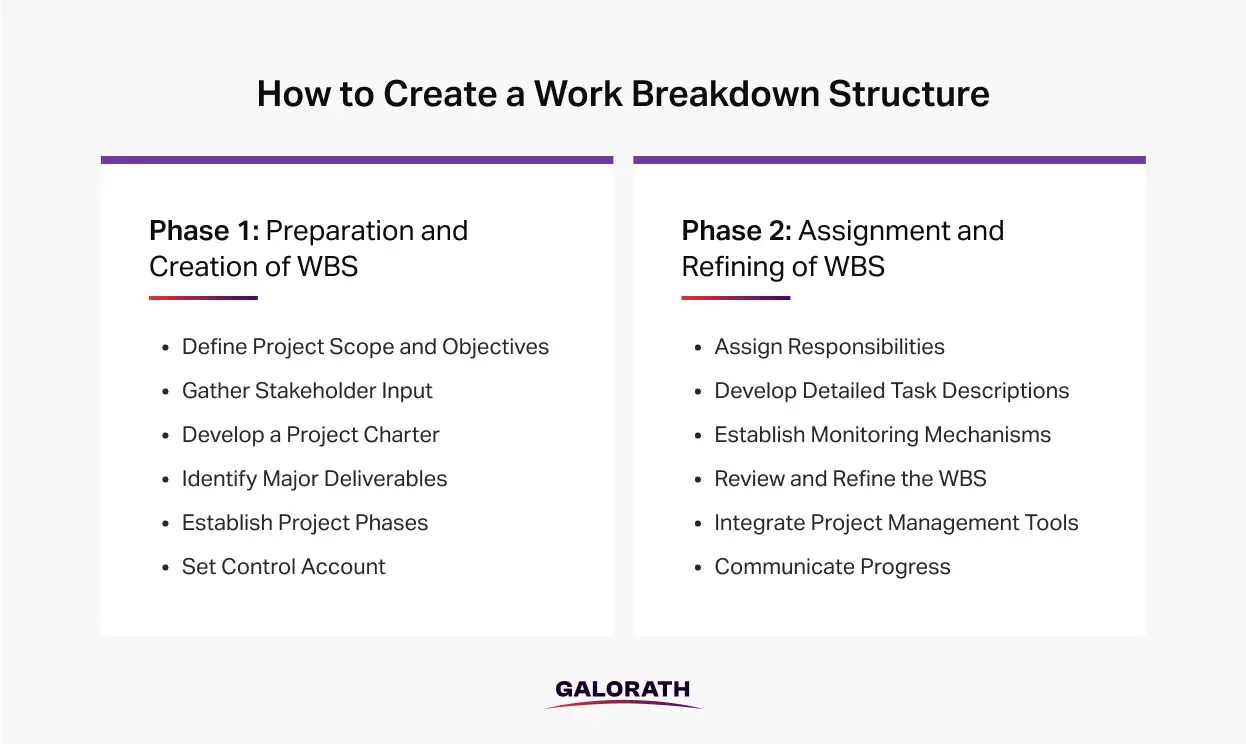
In which Formats is Work Breakdown Structure created?
A Work Breakdown Structure (WBS) is usually created as an Outline, Tree diagram, Spreadsheet or Gannt Chart, depending on project requirements, team preferences, and the level of detail needed. The choice of format impacts how the WBS is visualized, interpreted, and utilized for project management. Below are some of the most common WBS formats:
WBS Outline (List Format)
A WBS outline is a structured, hierarchical list that organizes project work in a numbered format. Each level of the WBS is indented or assigned a numbering convention (e.g., 1.0, 1.1, 1.1.1) to indicate the hierarchy of deliverables and tasks.
- Advantages: Simple to create, easy to modify, and well-suited for text-based project documentation.
- Best For: Smaller projects or when a high-level breakdown is needed without graphical visualization.
WBS Tree Diagram
A WBS tree diagram is a graphical representation that displays project components in a hierarchical, branching structure. The top-level deliverable is positioned at the highest point, with sub-deliverables and work packages branching downward.
- Advantages: Offers a clear visual structure, improves team understanding, and helps in stakeholder communication.
- Best For: Projects that require a structured visualization of work elements and dependencies.
WBS Spreadsheet
A WBS spreadsheet is a tabular format created using Excel, Google Sheets, or similar tools, where project tasks and their details are organized into columns and rows. Common columns include task ID, deliverable name, task owner, estimated duration, and dependencies.
- Advantages: Flexible, allows for data sorting and filtering, and integrates with other project management tools.
- Best For: Data-driven project management and when multiple attributes need tracking alongside the WBS.
WBS Gantt Chart
A WBS Gantt chart is an enhanced version of the WBS that incorporates a timeline, providing a structured view of task dependencies, durations, and scheduling. This format visually represents project tasks along a time axis, showing start and end dates for each work package.
- Advantages: Combines WBS structure with scheduling, helps track progress, and supports deadline management.
- Best For: Complex projects requiring detailed scheduling and tracking alongside task breakdown.
Each of these formats serves different project needs, and many organizations use a combination of these methods to manage project execution effectively. The choice of WBS format depends on the project size, complexity, and team collaboration needs, ensuring that the breakdown structure aligns with planning and tracking requirements.
Is WBS Used in IT Projects and Software Development?
Yes, WBS is widely used in IT projects and software development to structure complex projects and development work into manageable components. The work breakdown structure in software development organizes work into functional areas such as UI/UX design, backend development, database management, and testing. Each component is further divided into subcomponents, ensuring detailed task assignment and resource optimization.
According to Tausworthe in The Work Breakdown Structure in Software Project Management, “The work breakdown structure (WBS) is a valuable tool for managing software projects, linking objectives, resources, and activities, and promoting standard checklists for generating them.” This structured approach enhances transparency in software project execution and minimizes risks by clearly defining deliverables and dependencies.
Can Agile Methodology Use WBS?
Yes, WBS can be effectively used in Agile project management to provide structure and clarity while maintaining the flexibility Agile requires. Unlike traditional project management, where WBS is often used for detailed upfront planning, Agile teams adapt WBS to fit iterative development cycles.
In Agile environments, a Work Breakdown Structure (WBS) helps teams break down large user stories or epics into smaller, manageable tasks. This ensures clear task ownership and allows teams to track progress while aligning with Agile principles.
By integrating WBS with Agile frameworks such as Scrum or Kanban, teams can balance structured project planning with Agile adaptability, enhancing collaboration and efficiency.
Can You Use WBS for Project Cost Estimation?
Yes, a Work Breakdown Structure (WBS) is a powerful tool for project cost estimation because it provides a structured breakdown of all project components, allowing for precise cost allocation. By organizing work into detailed deliverables and work packages, project managers can assign estimated costs to each element, ensuring an accurate and transparent budgeting process.
How WBS Supports Cost Estimation:
- Breaks Costs into Manageable Units – Each task and deliverable is assigned a cost, making it easier to track expenditures.
- Enhances Budget Accuracy – Estimating costs at the work package level allows for precise forecasting and better financial planning.
- Facilitates Cost Control – As the project progresses, tracking actual costs against WBS-estimated costs helps identify budget overruns early.
- Improves Resource Allocation – Ensures that costs related to labor, materials, and overhead are properly distributed across work packages.
- Supports Risk Management – A structured WBS allows teams to assess financial risks tied to specific tasks and adjust budgets accordingly.
According to PMI’s Practice Standard for Work Breakdown Structures, “A well-defined WBS enables accurate cost estimation by ensuring that all necessary components of a project are accounted for, minimizing financial uncertainty.”
By integrating WBS with cost estimation software, teams can further enhance budgeting precision, track project expenditures in real-time, and ensure financial alignment with project goals.

